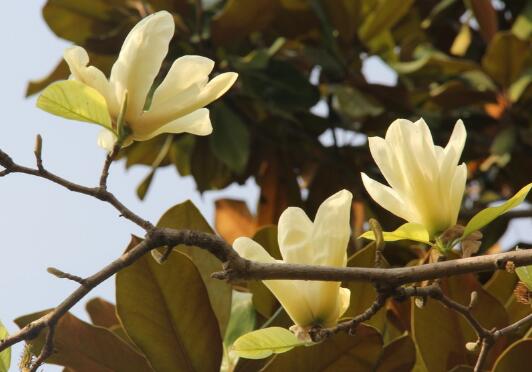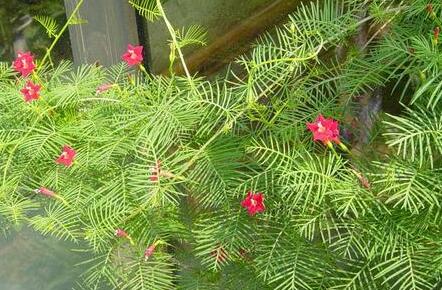How to propagate Magnolia, the method of propagation / sowing / cutting / grafting / striping of Magnolia
Magnolia is a kind of highly ornamental flower plant, which is cultivated in many areas of our country. With more and more people raising magnolia, people are more concerned about its reproduction. So how do magnolia reproduce? What are the breeding methods of magnolia? Next, the editor will take you to learn about it.
How to reproduce magnolia, sowing / cutting / grafting / striping

How to propagate magnolia is mainly divided into four methods: sowing, cutting, grafting and striping propagation, among which grafting and striping are more suitable for magnolia planted in the ground, while sowing and cutting are more suitable for potted plants. There are four methods of reproduction in detail below, let's take a look at them.
Second, the propagation methods of magnolia.
1. Sowing and reproduction
Before we sow and reproduce magnolia, we must first grasp the mature time of its seeds. Generally, when the magnolia turns red and cracked, we can harvest it. After harvest, we have to scrub it in cold water and remove the seed coat. Then record and remove the seeds to dry and collect, and wait until the next spring to sow. The adaptability of magnolia produced by sowing and propagation is very strong, and the effect is generally as good as that of grafted plants.
two。 Cuttage propagation
When we carry on the cutting propagation of magnolia, it is best to choose the time from May to June, and the cuttings had better choose the branches with strong growth and no diseases and insect pests, so that the survival rate of cuttings will be higher. When cutting, we can first use chopsticks to cut a hole in the basin soil, then insert the cuttings into it, and then pour water and wait for the cuttings to take root, so it is very practical to avoid damage to the cuttings.
3. Grafting propagation
The grafting propagation of Magnolia can be divided into two methods: grafting and grafting, in which the survival rate of grafting is relatively higher. The connection can generally be carried out during the period from April to July, and it is best to be away from the ground 70cm. After binding, it is wrapped in a mass of mud and wrapped in leaves, so that it can prevent the erosion of Rain Water, and then it can be cut off after about 60 days.
4. Striping propagation
Ordinary striping: striping propagation is best carried out in spring, we should cut the base of the branch that asks for elegance into half the depth, and then cut a section upward, with a tile stuck in the middle, then gently press it into the soil without breaking it, insert it into the soil with "U"-shaped thick iron wire, fix it, prevent it from warping, and then pile it on the soil, and then cut it apart and plant it after sending out root buds.
High branch pressing: we should select strong and tender branches on the mother plant, cut the cracks in the lower part of the basin fork, and then cover them with a bamboo tube or bottomless tile pot, which is filled with culture soil, tie it tightly with string on the outside, be careful not to touch it, often spray a small amount of water, keep it moist, and grow new roots around May of the following year.
Conclusion: after reading the above, I believe you also have a certain understanding of how magnolia breeds. The editor has introduced the breeding methods of magnolia here, hoping to bring some help to everyone's breeding process.
How do magnolia reproduce? Introduction to several propagation methods of magnolia
Magnolia, also known as Magnolia, Magnolia, etc., is a famous ornamental plant and traditional flower of Magnoliaceae. It is native to the provinces in central China. It is very sensitive to temperature and has a certain resistance to low temperature. It can survive the winter safely under a 20C condition. The main propagation methods are sowing reproduction, grafting reproduction, cutting propagation and striping reproduction. Let's take a look!
Magnolia magnolia sowing and propagation
Magnolia is the most suitable for autumn sowing. When the seeds mature from September to October, they can also be sowed in March-April of the following spring. Soak the seeds with warm water of about 50 ℃ before sowing, remove the waxy layer outside the seeds and remove the waxy layer, which can be rubbed with sand or soaked in 0.5% alkali water or plant ash water for 1-2 days. After sowing, cover 2 cm of soil, water thoroughly, cover grass, and often keep the soil moist. Generally, seedlings can emerge after about 2 months. Shade is needed in summer, anti-freezing in winter, and separate planting after soil thawing in the following spring.
Grafting propagation of Magnolia
Grafting propagation is the most commonly used method for propagation of Magnolia. It can not only maintain the quality of excellent varieties, but also blossom 2-3 years earlier than seedlings. 2-3-year-old Magnolia seedlings should be selected as rootstocks during grafting, and budding should be carried out from July to August. Cutting is carried out in autumn. After cutting, the scion should be covered with soil, and the soil should be removed in the late spring of the next year. It can also be cut and grafted in the greenhouse (autumn or winter), and then stored in wet sand. After the graft is healed, it will be transplanted before germination in the following spring.
Cutting propagation of Magnolia
Magnolia is not easy to take root and has a low survival rate, so this method of propagation is rarely used. However, if the base of the cuttings is stained with rooting powder or soaked in 25ppm's Tsai acetic acid solution for 20 hours before cutting, it can promote rooting and improve the survival rate. Cutting in June-July, cuttings are collected from the annual branches of Magnolia magnolia mother plant. The cuttings are 15 cm long and 2 leaves are reserved at the upper end. After cutting, we should pay attention to shading, watering, and often keep the soil moist.
Magnolia striping propagation
Magnolia crimping propagation is also used in more ways of reproduction, mainly divided into ordinary striping and high branch crimping.
1. Ordinary striping: ordinary striping is best carried out in February-March, cut the base of the branch to be taken into half the depth, then cut a section upward, and then stick a tile in the middle, then gently press it into the soil without breaking it, insert it into the soil with "U"-shaped thick iron wire, fix it, prevent it from warping, then pile it on the soil, press it in spring, and cut it apart after sending out root buds.
2. High branch pressing: select strong and disease-free twigs (1.5-2 cm in diameter) on the mother plant before entering, cut the cracks in the lower part of the basin fork, then cover them with bamboo tube or bottomless tile pot, fill them with culture soil, tie them tightly with string on the outside, be careful not to touch them, often spray a small amount of water, keep them moist, and grow new roots around May of the following year.
September! The most suitable month for flower breeding, sowing, cutting, grafting, ramet, striping should try ~ September! The month most suitable for flower breeding, sowing, cutting, grafting, ramet, and striping should be tried.
September is coming, which is a very lovely month. For flower friends, this is neither hot nor cold, which is very suitable for the season of flower growth, and it is also a good time for sowing, cutting, grafting, splitting and striping. Let's move along with Huahua!
Sowing seeds
The flowers that can be sown in autumn are: hollyhock, carnation, high snow wheel, dwarf snow wheel, pansy, goldfish grass, petunia, daisy, Yu beauty, calendula, black chrysanthemum, iris, beautiful cherry and so on.
In addition, greenhouse flowers such as cyclamen, primroses, golden lotus, melon and leaf chrysanthemum, four seasons begonia, Fulang flower, bao flower, can also be sown at this time, but to spend the winter in a plastic shed.
Huahua takes Petunia as an example. The specific operation methods are as follows:
1. After the peat soil, rotten leaf soil and perlite are fully mixed at 1:1:1, pour them into the seedling basin and compact them slightly.
2. Carbendazim was mixed with water 800 times to make carbendazim solution. The carbendazim solution first watered the soil in the seedling basin, and then poured water into the seedling box outside. Soak the seedling basin for one day and one night. After soaking, the soil was hung for 2-3 hours.
3. The suitable temperature for sowing is about 20-25 degrees. The basin soil should be watered once before sowing to ensure that carbendazim does not harm the seeds. Petunia seeds are very small, you can use spoons or toothpicks (water) scoop (dip) to take a seed on the soil, pay attention to a basin to put one on it!
4. Some clear water is injected into the bottom of the large seedling box, and the water level reaches about half a centimeter at the bottom of the small seedling basin.
5. Just put the lid or film on the astigmatism ventilated place. If there is no water, add water, wait 7-10 days, and then gradually see the sun.
Cuttage
The woody flowers that can be cultivated by cutting in autumn are: purple magnolia, Spiraea, pomegranate, hibiscus, crape myrtle, eight immortal flowers, figs, oleander, June snow, gardenia, star anise gold plate, peony, peony and so on.
Can also cut some grass flowers, such as a string of red, thousand-day red, marigold and so on.
Take hydrangea as an example, the specific operation methods are as follows:
1. Prepare materials.
Choose healthy and relatively strong branches. The medium can use fine vermiculite, fine seedling peat and so on. Try to use art knives and the like, do not cut with scissors, because scissors cut the wound is squeezed, and the knife cut is not the same.
2. Oblique cut about one inch below the node, which is only 35 centimeters.
3. Cut flat above the node to keep the bud.
4. Cut off the leaves by about 2/3 or 1/2. According to the size of the leaves, leave less for the big ones and more for the small ones.
5. Before cutting, the potted soil should be sterilized with potassium permanganate or carbendazim. Then the medium is thoroughly watered and filled with water. Insert the cuttings into the basin soil and insert all the parts below the nodes. Finally, put the basin into a tray filled with water and spray water frequently to moisturize it. (remember, don't put it in the sun.)
6. The current temperature takes about 20 days to take root, and it can be pulled out and put on the basin after a month.
Grafting
The flowers and trees that can be grafted in autumn are: peony with peony root as rootstock, peony with excellent varieties, cactus as rootstock, fine crab claw orchid, keel as rootstock, tiger thorn plum and so on.
Huahua rootstock is the same year peach seedling, and the scion is green plum branch as an example, the specific operation methods are as follows:
The main results are as follows: 1. The female parent should choose plants with blooming flowers and strong trees, and cut the buds with full growth and good growth.
2. The method of taking buds with three knives, draw and cut a shield about one centimeter around the selected bud, the lower part is slightly longer than the upper part.
3. Peel off the buds from the outside to the inside with your fingernails. After taking out the buds, you can put them in water to prevent water loss.
4. Draw the T-shape with a knife at the base of the rootstock 10 to 15 centimeters smooth, slightly longer than the bud, and use the back of the knife or fingernail to cut open the cortex.
5. Insert the bud and wrap it with plastic sheet.
Pressing strip
The species of ornamental flowers and trees that can be cultivated by pressing are: Begonia, brocade, eight immortals, gardenia, oleander, spring welcome, Admiralty, sweet-scented osmanthus, purple magnolia, jasmine, Michelia, camellia, pearl orchid, French holly, snowball, Qionghua, snowspray, Spiraea and so on.
Taking Gardenia jasminoides as an example, the operation method is as follows:
1. Choose the branches you like, which can be extra parts that need to be cut off, or twists and turns that are healthy and growing well.
2. Carve a ring of bark on the branch with a sharp knife, then peel off the bark. The width is 1-2 cm.
3. Make a funnel with a beverage bottle, cut it in the middle, put it on the ring and tie it with wire.
4. Put water-retaining materials such as culture soil into the beverage bottle and wrap them up and down with transparent film to avoid water leakage and soil exposure as far as possible. After a few days to replenish some water, maintain humidity, wait patiently, generally 2-3 months can take root.
5. After the root system is developed, the branches can be cut and planted directly. 6. The high pressure is successful, cut off and put on the basin.
The advantages of high-altitude striping propagation over cutting propagation are as follows: 1 thicker branches can be propagated directly. 2 the insurance coefficient is high, even if it does not take root successfully, the branch will not die.
Ramet
The plants that can be used for autumn ramet are: Cymbidium, Cymbidium, Jian Orchid, Paeonia lactiflora, Peony, Guangdong evergreen Chrysanthemum, Tiger tail Orchid, Little Angel, Kidney Fern, Phyllostachys pubescens, one-leaf Orchid and so on.
In addition, hyacinths, tulips, freesia, calla lilies, Lycoris radiata and so on can also be planted at this time.
Huahua takes plain sailing as an example, the specific operation methods are as follows:
1. Plain sailing, which has been raised for two years, has been very strong, and there are so many trees that a pot is almost out of place. At this time, ramets can be used to solve the problem.
2. Reverse buckle. If it is not easy to take out, you can pour some water first, and then use your thumb to top the drain hole under the flowerpot, and then you can take the soil out of the whole basin.
2. Separate the cultivated soil from the root system, do not harm the root system, especially the small root system.
3, need to divide into several pots, try to choose a basin with strong plants and young plants, in order to improve the survival rate.
4. Put the culture soil in the flowerpot and plant it smoothly after the ramet. Don't shine directly in the sun for the first few days, and when the root system recovers, you can let the flowers enjoy the sun.
Babies, if you have any other great experience about breeding in September, please submit your contribution or leave a message to Huahua.
- Prev

How to reproduce pineapple? when is the best time to sow pineapple / sowing in April?
Pineapple is a fast-growing plant, which is often cultivated as an annual plant, so after planting for a period of time, florists need to consider reproduction. Pineapple is also very characteristic in reproduction, it can reproduce by self-sowing, but family breeding generally needs artificial cultivation.
- Next

How to breed a string of red, when to sow seeds / spring or autumn sowing
A string of red figures can be seen in many places in life, and many flower friends will keep it at home to watch, one of the reasons is that a string of red has many functions, and reproduction is also very simple, so how can a string of red have a high survival rate? Let's take a look at the two most commonly used breeding methods of a string of red.
Related
- Fuxing push coffee new agricultural production and marketing class: lack of small-scale processing plants
- Jujube rice field leisure farm deep ploughing Yilan for five years to create a space for organic food and play
- Nongyu Farm-A trial of organic papaya for brave women with advanced technology
- Four points for attention in the prevention and control of diseases and insect pests of edible fungi
- How to add nutrient solution to Edible Fungi
- Is there any good way to control edible fungus mites?
- Open Inoculation Technology of Edible Fungi
- Is there any clever way to use fertilizer for edible fungus in winter?
- What agents are used to kill the pathogens of edible fungi in the mushroom shed?
- Rapid drying of Edible Fungi

